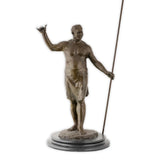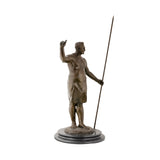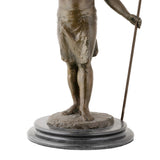“Hamana Kalili Shaka" Bronze Statuette by Kim Taylor Reece
- Product Description
- Reviews
-
Universal “Hang Loose” Shaka Sign Captured in Life-Like BronzeThis bronze statuette with a solid marble base honors Hamana Kalili, the father of the Hawaiian shaka hand sign. Famous in Hawaiian lore, Hamana originated the unique sign after he lost his three middle fingers in sugar mill accident. After the accident, the plantation owners assigned Kalili to work security on the plantation's train. Part of the job was to keep kids from joyriding as the train neared the station. Kalili would shout and wave at the children. HIs gesture looks strange and eventually became the shaka. The shaka can mean hello, how are you, hang loose and more. It has become an internationally recognized symbol.
- 22" High
- Made of Bronze
- Solid Marble Base
The famous award-winning photographer Kim Taylor Reece has studied Hawai'i's hula kahiko for 40 years and has created beautiful artworks to encapsulate the true Aloha spirit. Reece uses his colorblindness as an advantage to using a sepia tone to represent the timelessness of the dance.
-
This bronze statuette with a solid marble base honors Hamana Kalili, the father of the Hawaiian shaka hand sign. Famous in Hawaiian lore, Hamana originated the unique sign after he lost his three middle fingers in sugar mill accident. After the accident, the plantation owners assigned Kalili to work security on the plantation's train. Part of the job was to keep kids from joyriding as the train neared the station. Kalili would shout and wave at the children. HIs gesture looks strange and eventually became the shaka. The shaka can mean hello, how are you, hang loose and more. It has become an internationally recognized symbol.
- 22" High
- Made of Bronze
- Solid Marble Base
The famous award-winning photographer Kim Taylor Reece has studied Hawai'i's hula kahiko for 40 years and has created beautiful artworks to encapsulate the true Aloha spirit. Reece uses his colorblindness as an advantage to using a sepia tone to represent the timelessness of the dance.
">











